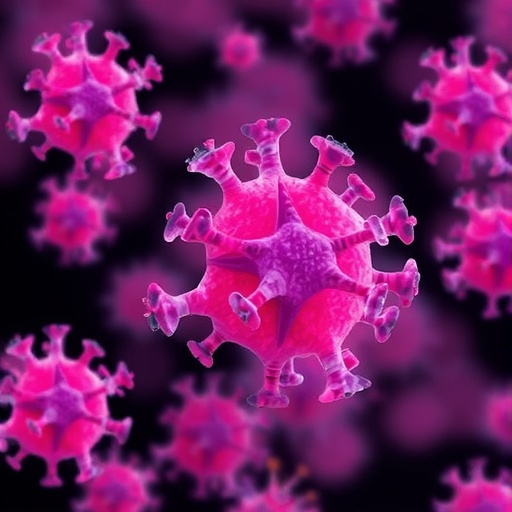In an era where antibiotic resistance continues to challenge modern medicine, a groundbreaking study offers a beacon of hope in the struggle against recurrent Clostridioides difficile infections (CDI). Researchers have introduced EVG7, a novel experimental glycopeptide antibiotic, which remarkably prevents the resurgence of this debilitating infection by selectively sparing key beneficial gut bacteria. Detailed in a recent publication in Nature Communications, this innovative approach represents a significant leap forward in microbial-targeted therapies, with profound implications for patient outcomes and antibiotic stewardship.
Clostridioides difficile, a notorious pathogen often unleashed after broad-spectrum antibiotic use, leads to severe gastrointestinal distress, including life-threatening diarrhea. The recurrent nature of CDI has confounded clinicians, as conventional antibiotics indiscriminately obliterate the gut microbiota, including taxa essential for maintaining microbial equilibrium. This dysbiosis creates an ecological niche primed for C. difficile overgrowth, perpetuating a vicious cycle of infection. Thus, strategies that preserve the native microbiome while eradicating pathogens are urgently needed.
EVG7 distinguishes itself through a highly selective mode of action targeting C. difficile while sparing taxa within the Lachnospiraceae family, a crucial group of commensal bacteria. Lachnospiraceae members contribute to the gut’s colonization resistance and metabolic functions, playing a pivotal role in inhibiting pathogenic colonization through competitive exclusion and short-chain fatty acid production. Traditional glycopeptide antibiotics lack this selectivity, leading to collateral damage in the microbiota and subsequent relapse of infection.
The development of EVG7 involved meticulous molecular engineering to hone binding specificity to C. difficile cell wall components. Glycopeptides typically interfere with bacterial cell wall synthesis by binding to D-Ala-D-Ala termini of peptidoglycan precursors, but EVG7’s structural modifications enable it to differentiate subtle variations in target organisms’ peptidoglycan architecture. This specificity spares structurally different beneficial bacteria, reducing the risk of dysbiosis.
Preclinical trials illuminated the therapeutic potential of EVG7 in murine models of recurrent CDI. Animals treated with the experimental antibiotic displayed robust clearance of C. difficile with no detectable relapse over prolonged periods, in stark contrast to controls receiving conventional therapies. Notably, microbial sequencing revealed preservation of Lachnospiraceae populations, correlating with restored gut homeostasis and immune modulation, underscoring the intrinsic relationship between microbiome integrity and pathogen control.
Mechanistically, the preservation of Lachnospiraceae fosters an environment unfavorable for C. difficile spore germination and vegetative growth. These bacteria produce metabolites, such as butyrate, that enhance epithelial barrier function and exert immunomodulatory effects, promoting mucosal health and reducing inflammatory responses. By safeguarding these beneficial microbes, EVG7 indirectly buttresses host defenses beyond direct bactericidal activity.
From a biochemical perspective, EVG7’s glycopeptide scaffold features strategic chemical substitutions enhancing hydrophobic interactions with C. difficile’s peptidoglycan while reducing affinity for other Firmicutes. This refined targeting minimizes the expansion of opportunistic pathogens and mitigates selective pressures that drive resistance. Furthermore, pharmacokinetic profiling indicated favorable bioavailability and gut retention, essential for targeting intestinal infections specifically without systemic side effects.
The implications of this study extend beyond CDI. The paradigm of narrow-spectrum antibiotics designed to spare critical beneficial microbiota could revolutionize infectious disease management. By preserving microbial diversity, such therapeutics reduce susceptibility to secondary infections, antibiotic-associated complications, and the emergence of multidrug-resistant organisms.
Clinical translation will necessitate extensive human trials to evaluate safety, efficacy, and potential resistance patterns. Additionally, integration with microbiome-based diagnostics may enable personalized treatment regimens, tailoring antibiotic use to individual microbial profiles for maximal benefit. Such precision medicine approaches align with the growing recognition of the microbiome as a key determinant of health and disease.
This research also prompts a reevaluation of current antimicrobial stewardship programs. Emphasizing selective agents like EVG7 could preserve gut microbiota health on a population level, reducing the burden of recurrent infections and healthcare costs. Moreover, understanding the microbiome’s role in treatment dynamics highlights opportunities for adjunctive therapies, including prebiotics, probiotics, and fecal microbiota transplantation in concert with precision antibiotics.
Notably, the study’s comprehensive use of high-throughput sequencing, metagenomics, and metabolomics provided a multidimensional understanding of microbiota shifts post-treatment. These technologies revealed not only taxonomic changes but functional alterations in microbial metabolic pathways, shedding light on complex host-microbe-pathogen interactions. Such insights pave the way for identifying biomarkers predictive of therapeutic success.
As antibiotic resistance escalates, the design of EVG7 embodies an innovative weapon in our pharmaceutical arsenal, sculpting antimicrobial activity with unprecedented specificity. Its ability to break the recurrent CDI cycle without compromising beneficial flora represents a milestone in harnessing microbial ecology for therapeutic gain. This model underscores a future where infection control harmonizes with microbiome preservation.
Ultimately, the EVG7 study redefines the concept of an antibiotic, transforming it from a blunt instrument into a precision tool that aligns microbiology with host physiology. By safeguarding Lachnospiraceae and, thereby, gut microbial diversity, this approach honors the intricate balance underlying human health. The success of EVG7 may signal a new era in infectious disease treatment—one where the microbiome is not collateral damage but a crucial ally in combating disease.
The combination of cutting-edge molecular design, rigorous preclinical validation, and profound microbiome insights renders EVG7 a compelling candidate poised to reshape how we confront CDI and, more broadly, antibiotic-resistant infections. As further clinical development advances, this work challenges prevailing notions and invites a shift toward more harmonious, targeted antimicrobial strategies that respect and leverage our microbial partners.
The potential ripple effects on global health are immense. By reducing CDI recurrence and minimizing antibiotic-induced dysbiosis, EVG7 could curb hospitalization durations, decrease healthcare resource utilization, and improve quality of life for countless patients. This innovation epitomizes how integrating microbiological precision with clinical need can create therapies that are as elegant as they are effective.
In reflecting on the broader landscape, EVG7 heralds a transformative future—one where antibiotics are crafted not merely to kill but to communicate, preserve, and balance. It calls for a renaissance in antimicrobial research, focused on understanding and nurturing the complex microbial ecosystems integral to human wellbeing. The dawn of such selective, microbiota-conscious therapies marks a pivotal chapter in the ongoing evolution of medicine.
Subject of Research: Recurrent Clostridioides difficile Infection and Microbiome-Sparing Antibiotic Therapy
Article Title: Experimental glycopeptide antibiotic EVG7 prevents recurrent Clostridioides difficile infection by sparing members of the Lachnospiraceae family.
Article References: Mons, E., Henderickx, J.G.E., Sanders, I.M.J.G. et al. Experimental glycopeptide antibiotic EVG7 prevents recurrent Clostridioides difficile infection by sparing members of the Lachnospiraceae family. Nat Commun 16, 9017 (2025). https://doi.org/10.1038/s41467-025-64067-w
Image Credits: AI Generated
Tags: antibiotic resistance solutionsantibiotic stewardship strategiesbeneficial gut bacteriaClostridioides difficile treatmentecological niche for pathogensEVG7 antibioticgastrointestinal health innovationsglycopeptide antibiotic researchgut microbiome preservationLachnospiraceae familymicrobial-targeted therapiesrecurrent CDI infections





